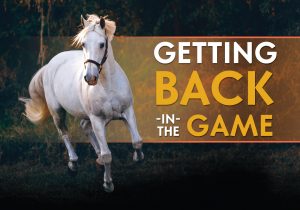Getting Back in the Game
Click here to read the complete article
It is no stretch to say that COVID-19 has changed the way the world works, and, in many cases, performance horses have felt the effects, too. With states shutting down, many boarding facilities closed or limited access to their customers. In some cases, trainers had to pull back from how they could provide training and lesson services, and shows were cancelled left and right. Some state breed associations cancelled their entire seasons citing state mandates or insurability concerns.
That slow start to the show year, followed by the roller coaster-like schedule that has resulted, has left many horses poorly conditioned to do their jobs. Among all this back and forth, and as much as exhibitors want to get back in the game in 2020, the importance of conditioning their equine partners remains paramount for what remains of this year’s show season and for the longevity of an animal’s career.
Start with the Basics
If, during the pandemic or during any lengthy time without physical activity, a horse has become a couch potato, it’s important to evaluate a few basics before stepping on for that much-anticipated first ride back, says John Bengfort, DVM, of Bluff Country Equine in Winona, Minn. The first question to consider is whether farrier work has been interrupted. If so, it may require more than one trimming to restore balance in the horse’s feet. Next, consider the horse’s current body condition and whether it affects the fit of the saddle. Loss of muscle, particularly in the topline, or increased fat overall can cause pinching or rubbing that doesn’t occur when the horse is in good physical condition. Finally, assess nutritional needs. If the extent of the horse’s physical activity has been less than that of a Zoom meeting, he may be fat and need a slight cut in his grain to help him regain fitness. Alternatively, if his grain was reduced to accommodate lesser activity, consider increasing it to offset calories burned and maintain a healthy weight. Bengfort suggests that a horse that’s been laid off during the shutdown be eased into a conditioning routine by starting with basic groundwork, stretching, and walking before anything more strenuous.
Information from Kentucky Equine Research (KER) also suggests that a conditioning program begin slowly and then gradually push the horse beyond its current level of fitness. “The trainer must ask the horse to do somewhat more work than it is used to doing… significant enough to produce an effect in which the body responds by building muscle strength, increasing cardiovascular fitness, and augmenting respiratory efficiency,” KER reports.
Once fitness is built in those three areas, a training program should continue to build workload by adding time or difficulty to the exercise. According to Bengfort, three months or longer is a realistic timeline for regaining physical fitness in most performance horses, though it varies by individual and discipline.
Seek Gradual Improvement While Focusing on Long-term Goals











